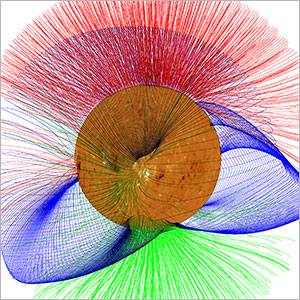

Space Weather
While Earth's weather reports center on precipitation, temperature, wind direction and velocity, and humidity, space weather forecasts attempt to predict activity that occurs on the sun -- and how the particle and electromagnetic radiation caused by that activity will affect Earth.
NSF supports scientists who track the development of sunspots, flares and coronal mass ejections (giant clouds of solar plasma that are blown away from the sun during strong solar flares). These researchers are working to better understand how and when these phenomena affect the sun's magnetic field. That magnetic field can wreak havoc on Earth's power grids, satellites and communications systems.
Featured video: When Nature Strikes -- Science of Natural Hazards: Space Weather
Space weather has the potential to interfere with everything from satellite communications to electrical power. Atmospheric scientists and geospace researchers are studying the behavior of the sun to develop warnings of solar storms that may be coming Earthâs way. "When Nature Strikes" was produced by NBC Learn in partnership with NSF.
RELATED NEWS
- Springtime night lights: Finding the aurora (Discovery)
- Tiny Firefly Satellite Set To Flash Straight Into Lightning and Thunderstorms (Discovery)
- Small Satellite Takes on Large Thunderstorms (News Release)
- More to Solar Cycle Than Sunspots (News Release)
- Plasma Jets Are Suspect in Solar Mystery (News Release)
- Scientists Issue Unprecedented Forecast of Next Sunspot Cycle (News Release)
- Scientists Create First Comprehensive Computer Model of Sunspots (News Release)
- Understanding How Space Turbulence Works (Discovery)
- Solar Cycle Linked to Global Climate (News Release)
- Connections among Solar Cycle, Stratosphere and Ocean Discovered
RESOURCES
- Trailer for "Solar Superstorms," a co-production of Spitz Creative Media, the National Center for Supercomputing Applications' Advanced Visualization Lab, and Thomas Lucas Productions, Inc., in association with the Fiske Planetarium at the University of Colorado (Boulder). The project was made possible with support from the Commonwealth of Pennsylvania and the Pennsylvania Film Office, and with funding by NSF.
- Sunspots Revealed (Science Nation video series, September 14, 2009)
Any opinions, findings, conclusions or recommendations presented in this material are only those of the presenter grantee/researcher, author, or agency employee; and do not necessarily reflect the views of the National Science Foundation.
